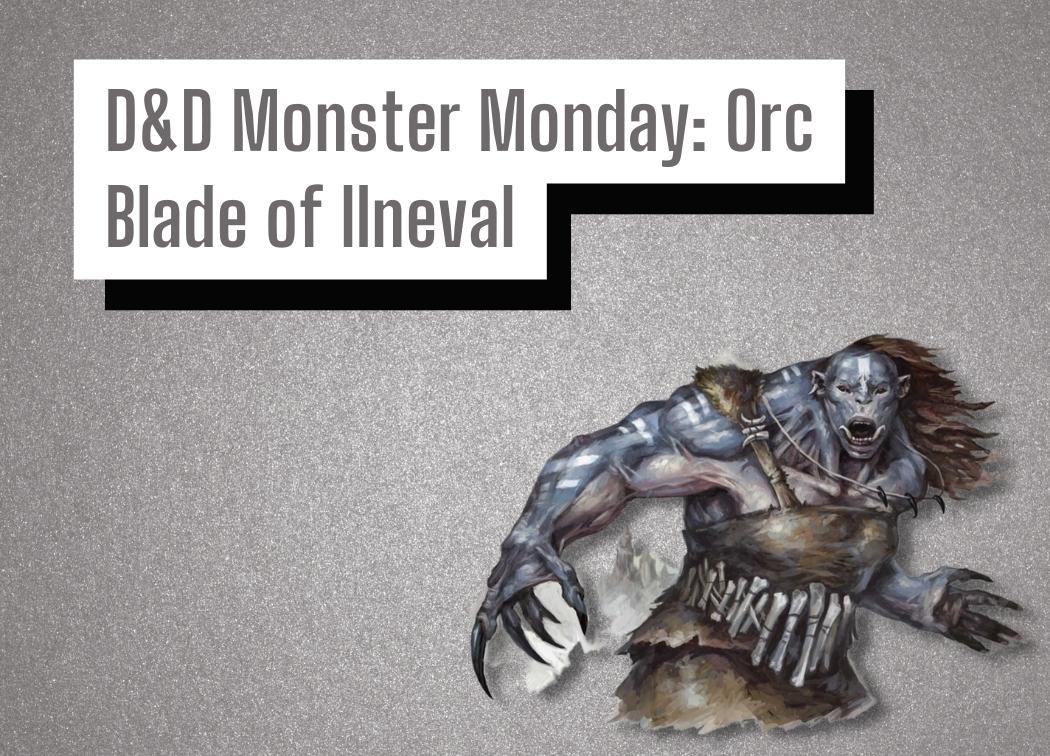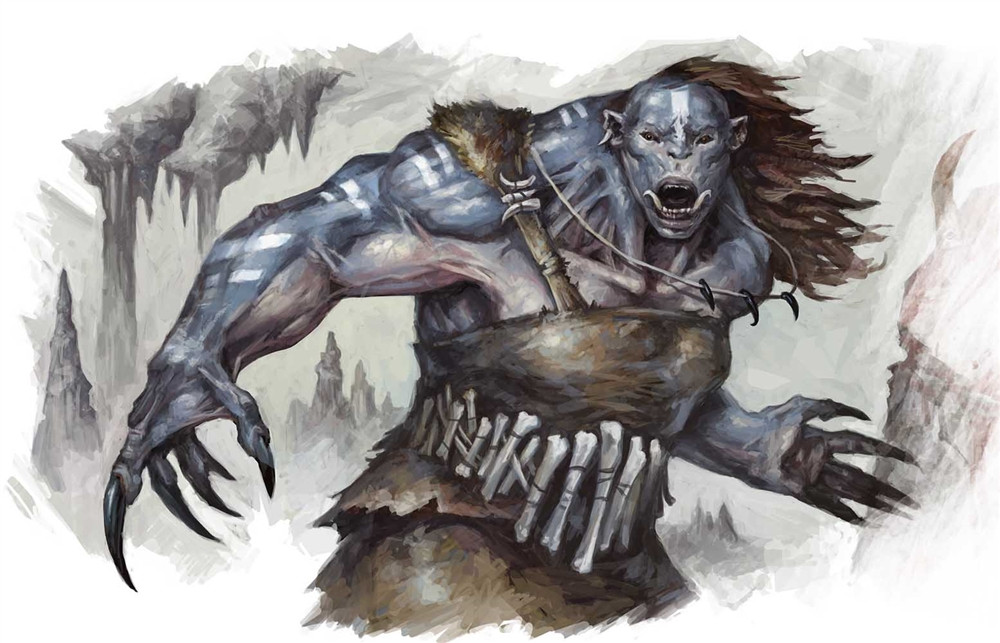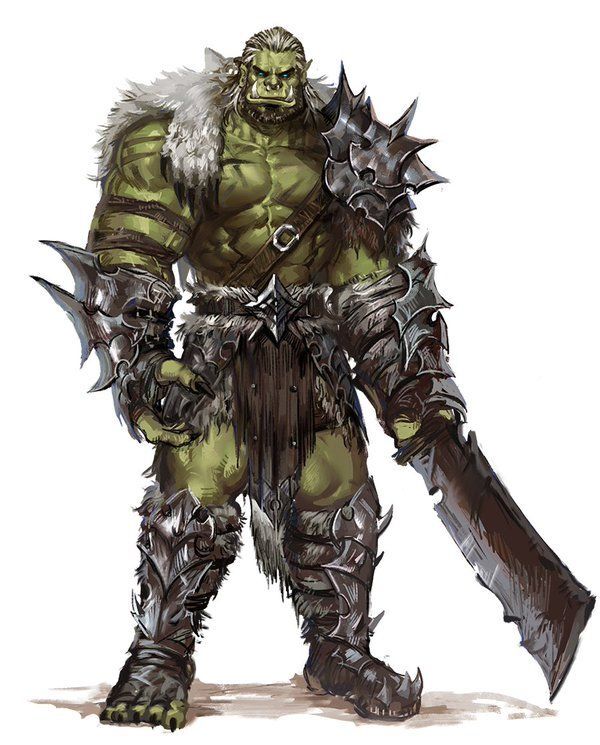D&D Monster Monday: Orc Blade of Ilneval

You cheer as you watch the remaining orc raiders retreat. Though your celebration is short-lived as you hear the orcish horns bellow again. This time you see the clan’s heavily-armored Orc Blade of Ilneval flanked by a few tanarukks advance upon the village you’ve so desperately fought to defend.
Orcs have earned their reputation as the fearsome raiders of D&D. There are few creatures as ruthless and terrifying to the common person in the D&D world.
Are dragons more powerful? Absolutely, but they’re by no means as real of a threat to an everyday villager as a band of orcs riding into their small farming village.
However, the stereotypical orcish raider is only a small fraction of orcish culture and life. We’ve already discussed the fearsome and unnatural tanarukk. Today we’re going to explore another sect of orcish culture. The wise master of the blade, the Orc Blade of Ilneval.
Let’s charge into Volo’s Guide to Monsters and take a look at these orcish blademasters!

Orc Blade of Ilneval Lore
An Orc Blade of Ilneval is often referred to as a blade. Trust me, it’s in the lore. I’m not just making this up to avoid typing “Orc Blade of Ilneval” a million times.
A blade is an orc who has gained favor with the lesser deity, Ilneval. This is generally accomplished by an orc showcasing reverence to Ilneval as well as their tactical genius on the battlefield.
Blades are both the most ferocious warriors and the unmatched tacticians of an orc tribe. They are the right-hand orcs of the tribe’s chieftain concerning war tactics and strategy.
A blade knows how to implement unorthodox, yet effective strategies. They also know how to lead their less tactically-gifted allies even in the most chaotic of battles.
Orc Blade of Ilneval Stats and Abilities
You can find the Orc Blade of Ilneval’s statblock on pg 183 of Volo’s Guide to Monsters.
Stats
Size: Medium humanoid (orc)
AC: 18 (chain mail, shield)
HP: 60 (8d8 + 24)
Speed: 30 ft.
STR: 17 (+3)
DEX: 11 (+0)
CON: 17 (+3)
INT: 10 (+0)
WIS: 12 (+1)
CHA: 14 (+2)
All in all, this is a well-rounded statblock. It pains me to not see the blade’s 17’s in Strength and Dexterity not be 18’s. However, it’s an o.k. the tradeoff for avoiding any negative modifiers in their ability score array.
Despite it not immediately seeming that way, blades have a solid overall bonus to all three of the common saving throws. Their Dexterity modifier is still weak, but they have proficiency in Wisdom Saving Throws so they at least have +3 in two of the three.
Their AC is solid on paper as long as they equip their shield. While they can opt to ditch the shield and wield their longswords with 2 hands for additional damage, I wouldn’t recommend doing so. The +2 to AC is well worth the damage output tradeoff. Especially since they lack any damage resistances and immunities.
Resistances, Immunities, Saves, and Skills
Saving Throws: Wis +3
Skills: Insight +3, Intimidation +4, Perception +3
Senses: darkvision 60 ft., passive Perception 13
Languages: Common, Orc
CR: 4 (1,100 XP)
One of my favorite parts about the Orc Blade of Ilneval’s statblock is that it showcases their leadership skills using skill proficiencies. It even goes so far as to showcase their specific wartime leadership by opting for Intimidation rather than Persuasion.
I can’t stress enough that I love when creatures have proficiencies in skills other than Perception. While Perception is a fantastic skill for combat, it’s great when the DM has creatures that have strengths outside of combat too.
The only issue I have with this section of the statblock is that blades don’t have any damage resistances/immunities or condition immunities. Thematically this makes sense, but it’s a weak point.
Traits and Abilities
Aggressive. As a bonus action, the orc can move up to its speed toward a hostile creature that it can see.
Foe Smiter of Ilneval. The orc deals an extra die of damage when it hits with a longsword attack (included in the attack).
Aggressive is a solid trait that orcs share in 5e. It gives them both a boost to their action economy and a bit of extra movement which is valuable for creatures that tend to favor melee combat.
Foe Smiter of Ilneval is a nice flavorful addition to showcase their mastery of the blade.
Actions
Multiattack. The orc makes two melee attacks with its longsword or two ranged attacks with its javelins. If Ilneval’s Command is available to use, the orc can use it after these attacks.
Longsword. Melee Weapon Attack: +5 to hit, reach 5 ft., one target. Hit: 12 (2d8 + 3) slashing damage, or 14 (2d10 + 3) slashing damage when used with two hands.
Javelin. Melee or Ranged Weapon Attack: +5 to hit, reach 5 ft. or range 30/120 ft., one target. Hit: 6 (1d6 + 3) piercing damage.
Ilneval’s Command (Recharges 4–6). Up to three allied orcs within 120 feet of this orc that can hear it can use their reactions to each make one weapon attack.
The blade’s Multiattack is jam-packed with action economy goodness. They have a total of two attacks per action regardless of the weapon they use. In addition to that, they don’t need to choose between using their utility-based Ilneval’s Command or dealing damage. They can do both!
Longsword is a solid attack dealing a total of 24-28 damage per Multiattack depending on how they’re wielding their blade. Although, I’d strongly recommend opting for a 1h sword & shield combo. The +2 AC bonus is worth missing out on 4 average damage per turn.
While they should always opt to use Longsword thanks to Foe Smiter of Ilneval, the option to make ranged attacks is still welcome.
Ilneval’s Command is fantastic. It boosts three different orcs’ action economies as well as the creatures’ total damage output each round it’s used. In addition to that, it’s got a solid recharge rate of 50%. This is both a flavorful and deadly addition to the blade’s kit.
Orc Blade of Ilneval Strengths
Well-Rounded Combatants
While their damage per turn is quite average for a CR 4 creature, blades showcase their strengths in battle in other ways. There’s more to fighting than brute strength after all.
One such way is how well-rounded they are. There’s nothing they can’t do with their kit. They have melee attacks, ranged attacks, utility, great movement, and solid physical defenses.
This gives blades the ability to thrive and assist their orcish brethren in a multitude of situations. They’re the Swiss Army Knife of an Orcish Warband.
Plentiful Utility
As the leaders and tacticians of their respective tribes, blades are skilled commanders and an asset on the battlefield.
Ilneval’s Command is the most obvious form of utility that they provide. First of all, it doesn’t even intrude on their damage output. If it’s available they can use it.
It simultaneously boosts the orcs’ total damage output and their action economy by using the often-untouched Reaction of the blade’s orcish allies. For reference, using this to give three run-of-the-mill orcs an extra Greataxe attack generates an average of 27 additional slashing damage per turn.
That’s huge.
I feel it’s also pertinent to reference the blades’ out of combat utility as well. Having three different skill proficiencies is a huge boon to their kit. Especially where two of the skill proficiencies can be used effectively during social situations.
Also, the versatile property of their longsword allows blades to choose between additional damage or defenses as the encounter progresses. While I’d almost always opt to use the shield, it’s nice to have the option to dish-out some extra damage.

Fantastic Action Economy
The blades’ Multiattack boasts the usage of up to three separate actions per turn. That’s an enormous amount of value for a single action.
Ilneval’s Command won’t always be available, but its generous recharge rate gives it a solid chance of being used a few times per encounter.
Aggressive also deserves a mention here as it gives an otherwise unused bonus action a function. Plus it increases the blade’s movement to 45 ft. per turn which is respectable. It’s also quite welcome for a creature that thrives in melee combat. Getting into melee range is essential to make the most of their kit.
Orc Blade of Ilneval Weaknesses
Susceptible to Crowd Control
Blades do have a solid chance of making a wide variety of saving throws. However, they have no secondary defense mechanism if they fail the roll.
Their lack of condition immunities and even damage resistances/immunities are their weakness.
Slowing down a blade or outright preventing their ability to move and attack is a surefire way to turn the blade of ilneval into a useless piece on the board. What’s more is that by crowd controlling a blade, you make every other orc under their leadership weaker by taking away Ilneval’s Command.
Preventing a blade from functioning is the best strategy for dismantling their Warband or raiding party.
How to Play an Orc Blade of Ilneval
Use Your Pawns
Look, we can’t all be kings. We must realize this sooner than later.
Orcish warbands are no different. The majority of their forces are going to be pawns. It just so happens that the blade knows how to utilize them effectively. They’ll bark orders at them, giving them optimal targets to swarm and defeat.
While a blade can work with just about any creature, you should use orcish units alongside them to make the most of their Ilneval’s Command as it only targets orcish allies. Thankfully, Volo’s and the Monster Manual have plenty of options outside of a basic orc.
However, you want quantity over quality. Having a multitude of options to choose from for your Ilneval’s Command is ideal. The more pawns you have on the battlefield, the longer you’ll get the full-value of Ilneval’s Command throughout the encounter.
I’m being realistic here. The party’s going to clean up a ton of orcs before they drop your blade. Having more than 3 other orcs from the get-go just means that you’ll make the most out of your blade!

Recognize the Threat and Target It
The blade’s identity revolves around them being the wise tacticians of their clan. The best way to showcase this in play is to have them recognize the opposition’s largest threat and direct their allies to thwart it.
It’s nice that this is also an optimal tactical strategy too.
In most cases this is going to be the party’s magic users or backline ranged attackers. Magic users will take precedence 9 times out of 10 though due to their ability to crowd control the blade, rendering them useless.
Utilize the blade’s and their orcish allies’ Aggressive trait to make a beeline toward the raiders’ biggest threat and neutralize it A.S.A.P!
5 Orc Blade of Ilneval Plot Hooks
- The WARchief – It appears the inevitable assault is still set to launch despite capturing the orc clan’s cheiftain. Who could still be leading the raiders?
- Clerics of Ilneval – Traveling through the forest you see three orcs praying next to the nearby lake. You see they each have a longsword laid before them and they seem to be coating their blades in blood.
- An Organized Army – The city has suffered historic and devastating losses after this most recent raid. Who or what could have taught the orcs such deadly tactics?
- The Celebration – It’s said that once a year all the orcs in the valley gather to ravage the countryside in the name of Ilneval. Is there another way to satisfy their god other than senseless bloodshed?
- The Raiders – A small gang has taken up disrupting the trade routes throughout the plains. The few merchants that survive all say that the raiders wear an amulet in the shape of a bloodied sword.
Conclusions
All in all, blades are solid creatures. They have a ton of variety and utility dumped into their kit while still having a couple of key weaknesses that the party can use to their advantage. They’re an interesting, but fair creature.
Their Ilneval’s Command can make for a more greedy playstyle for a band of orcs by frequently giving a few of them an additional attack. Plus, they’re well-known for implementing unorthodox, yet effective strategies, making your wacky plays lore-friendly!
The Orc Blade of Ilneval is a fantastic addition to any mid-level adventures containing orcs. They bring a solid amount of utility and a ton of great flavor to the table. Use them to enhance even the most basic orc encounters.
